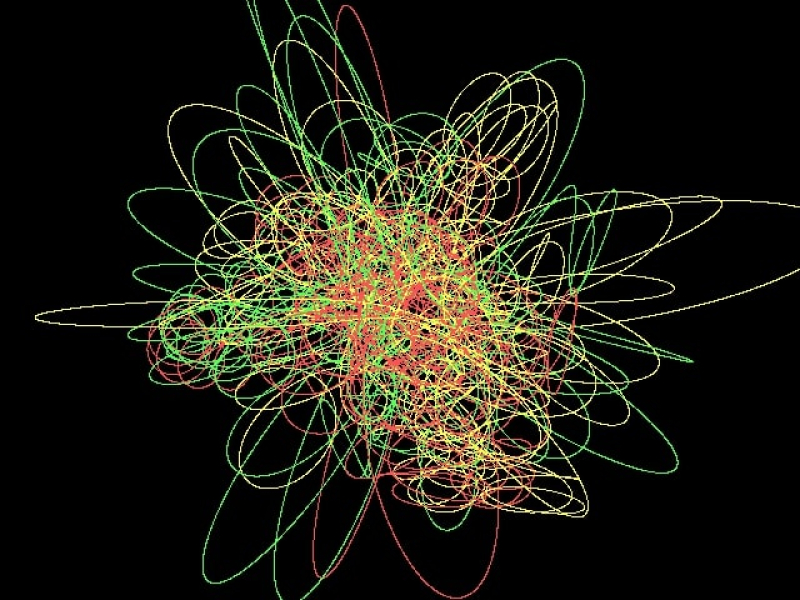Within the novel's alternate history, Chinese scientists contact an alien civilization during the Cultural Revolution. The title itself refers to an actual problem in orbital mechanics that cannot be solved analytically.
The three bodies or point masses in the problem move with their initial velocities and orbit each other; the task is to calculate the location of each body in space at any given time, taking into account Newton's laws of motion and Newton's law of universal gravitation. It might seem simple, but physicists have only succeeded in providing computational solutions to the problem and describing single cases. The general solution, which was developed in the early 20th century and would potentially make it possible to calculate the three bodies’ trajectories with any given initial coordinates, is not applicable in practice.

20 special-case solutions of the three-body problem. Credit: Wikimedia Commons / CC BY-SA 4.0
The three-body problem in science…
First, scientists established the two-body problem: the task of predicting the motion of two bodies that interact only with each other. This problem was studied by Johannes Kepler, a German scientist who was the first to describe the movement of planets in the Solar System (known now as Kepler's laws of planetary motion), noting in particular their elliptical orbits. Isaac Newton also contributed to the problem’s solution by formulating the laws of motion and universal gravitation.
How much would change with the addition of a third body? Turns out, quite a bit: the third body makes the problem much more complex in terms of math. Whereas the two-body version can be solved by calculating the movement of just one body and making the other a reference point, the three-body problem cannot be calculated similarly.
Leonhard Euler and Joseph-Louis Lagrange, the founders of analytical mechanics, were the first to tackle the problem and find several special-case solutions. For instance, Lagrange solved the problem for equal mass bodies that start their movement at the apexes of an equilateral triangle. Euler, on the other hand, suggested solutions for cases in which the three masses lie along a straight line or parallel lines at any given time.

Approximate trajectories of three identical bodies that started moving at the apexes of an equilateral triangle with zero initial velocities. Credit: Njarlatotep / Wikimedia Commons / CC0
A huge leap for the three-body problem was made by the mathematician Henri Poincaré, who demonstrated that the problem has an infinite number of solutions. Depending on the bodies’ starting points, their movement trajectories can be completely different. To calculate them, the starting location for each of the bodies must be known; however, contemporary astronomy could not identify such locations with high enough precision – this would lead to errors in calculations that would affect the calculated body movement trajectories.
Finally, in 1912, it seemed like the problem was solved: the Finnish mathematician Karl Sundman proved that there is a general analytical solution involving infinite series. However, it didn’t render a lot of practical benefits, as it still didn’t solve the issue of determining the bodies’ initial locations.
In 1967, the astronomers Viktor Szebehely and Frederick Peters, who contributed to the Apollo space program, created a simulation that demonstrated that if the mass of one of the bodies is different from those of the other two, such a three-body system will not be able to exist – two of the bodies would inevitably collide. The system would work only if all masses are either equal or hierarchical.
Researchers are still looking for solutions to the three-body problem, now also using neural networks. There are currently 12,409 periodic solutions.
Why do we need to solve it? The problem is one of the main models for studying chaos (systems where small initial changes cause drastically different movement trajectories) and can help in research of actual ternary star systems using astronomical observations.

Image generated in Shedevrum
…and in sci-fi
In Liu Cixin’s novel, aliens live in such a three-body system on Trisolaris, a planet with an unstable orbit around the actual ternary star system Alpha Centauri. Because of the planet’s unstable movement trajectory, the Trisolaris civilization periodically goes through Chaotic Eras, when the planet circles too close to the stars or too far from them. That’s why it’s so important for Trisolarians to determine the movement of the three suns and predict their Chaotic Eras. And if they fail to do so, they are prepared to conquer Earth and make it their new home.
To capture the hearts of Earthlings and tell the planet’s tale, Trisolarians create a VR game called Three Body. They also use the software to try and provide a numerical solution to the three-body problem by building a human computer inside the game – there, every player is a binary digit, either 1 or 0. Thus, millions of people turn into a system of transistors performing complex calculations with colored flags.
Are “human computers” even possible?
Theoretically, yes. But for this, we would need a lot of space to gather all the participating people. Next, we’d need some kind of flying device to monitor the calculations. This is where we face a contradiction: if the aliens have such a flying device, it means they understand mechanics and thus can create at least primitive computing devices. Even the simplest of them would be performing calculations much faster than a “human computer” – then why bother with the flags in the first place? That’s why, even if such computers could be recreated, it’s unlikely that they’d be beneficial.
However, such human computers have actually existed in real life. In the early 20th century, “computer” was the term for someone who dealt with calculations: in teams, computers conducted complex calculations on paper or using various devices. For instance, this method was used to calculate NASA rocket trajectories or develop the atomic bomb.

Stanislav Baturin. Photo by Dmitry Grigoryev / ITMO.NEWS
Physicists, demotivated
Trisolarians were ready to occupy Earth to save themselves. One of their tactics was to send sophons, AI-enriched quantum particles, to Earth; these particles can spy on people and transmit the information back. Sophons also disturb scientific research: they enter colliders, mess with experimental results, and baffle scientists. This causes many to grow disappointed in science and start to believe that physics doesn’t exist – as the formerly established laws are no longer true.
In real life, you can also encounter quite a few reasons to quit: not every experiment goes according to plan. Many factors affect the results; some are natural but aren’t accounted for in theories or problem descriptions. That’s why it’s so important for scientists to separate such errors and noise from actual data in order to conduct successful experiments.
Stanislav Baturin’s lecture on The Three-Body Problem was held in Mayakovsky Central Public Library on October 29. The event was part of a sci-fi talk series co-organized by ITMO’s School of Physics and Engineering and the Mayakovsky Central Public Library.





